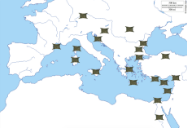No ox?
The Haifa ingots are rectangular, which sets them apart from the typical ‘oxhide’ shape, which was the standard for most Bronze Age ingots (Fig. 2 and 3). Copper oxhide ingots were twice the size of the Haifa ingots: circa 65 cm versus 30 cm in length. Why were the oxhide ingots shaped this way? At first, academics speculated whether the shape signified the value of the ingot: that of one ox. Nowadays, however, the common opinion is that the ingots are shaped this way to make them easier to carry over land. The handles provide an easier way to lift the blocks and carry them on one’s shoulder. Additionally, the handles provide a place to tie the ingot to the saddle of pack animals for land transportation over longer distances.
Because of their smaller size, the Haifa tin ingots could have been carried in bags and other containers. This would explain why there was no need for handles to carry or fix the ingots to the backs of pack animals. But why were those tin ingots smaller than the copper oxhide ingots? There are two practical explanations: because of its scarcity, tin was likely more expensive than copper. Tin was, therefore, probably easier to sell in smaller quantities. Similarly, ingots of gold are nowadays often smaller than steel ingots. Moreover, a large portion of copper and only a small portion of tin were needed to produce an alloy that was of great importance in that age: bronze.
](https://micrio.thingsthattalk.net/QyNyH/views/max/191x128.jpg)
